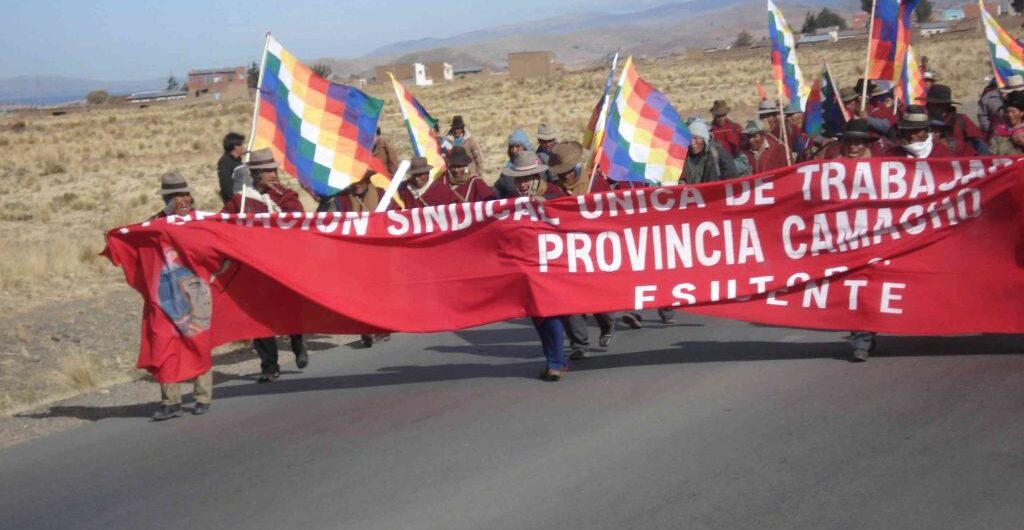When travelling in Bolivia it is usually not really the safety in Bolivia that you have to worry about. A popular saying in Bolivia is: “Todo posible, nada seguro”. This means that in Bolivia everything possible is, but there are no guarantees. It means that when you travel in Bolivia you have to be flexible and be prepared that travel schedules don’t always go as planned.
Safety questions about Bolivia
What about safety in Bolivia? How safe is it to travel by bus in Bolivia? Are overnight buses in Bolivia safe to travel with? Is it safe to travel by myself? Is it safe for me to travel through Bolivia as a solo female traveller? It are all questions we receive frequently and they don’t surprise us. If you consider that a country like Bolivia is more likely to reach mainstream news when something negative has happened, it is only natural that people who have never travelled to South America will feel more cautious. However, the problem is how to answer these questions about safety in Bolivia? Yes, they grow coca leaves in Bolivia, but no, it is very, very unlikely that your get caught up in any drug war. The most common crimes against tourists are usually crime of opportunity.
Is Bolivia a safe country?
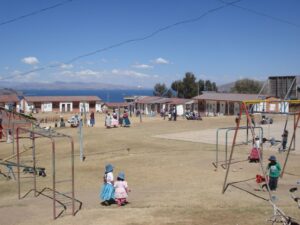 That’s a difficult question to answer. What is considered a safe or unsafe place is partly a projection of someone’s own previous experiences. When you grow up in downtown Houston, or in the countryside of the Netherlands, your perception of safety will be different. If you have travelled for many years through Latin America, or you have never left your own country, your perception of safety will be different. So how to divine the safety in Bolivia? The Institute of Economics and Peace examined the safety of 162 countries and compiled a Global Peace Index list. Number one is the safest country to live and number 162 is the most dangerous country to live. According to this list for 2024, Iceland is the safest country in the world to live and Afghanistan is the most dangerous country in the world. Bolivia is at place 77 in this list, while Ecuador is at place 96, Peru at place 102 and the Netherlands on place 16. Surprisingly the USA is at place 130… Does this mean that it is safer to travel in Bolivia than to travel in Peru, or even the USA?
That’s a difficult question to answer. What is considered a safe or unsafe place is partly a projection of someone’s own previous experiences. When you grow up in downtown Houston, or in the countryside of the Netherlands, your perception of safety will be different. If you have travelled for many years through Latin America, or you have never left your own country, your perception of safety will be different. So how to divine the safety in Bolivia? The Institute of Economics and Peace examined the safety of 162 countries and compiled a Global Peace Index list. Number one is the safest country to live and number 162 is the most dangerous country to live. According to this list for 2024, Iceland is the safest country in the world to live and Afghanistan is the most dangerous country in the world. Bolivia is at place 77 in this list, while Ecuador is at place 96, Peru at place 102 and the Netherlands on place 16. Surprisingly the USA is at place 130… Does this mean that it is safer to travel in Bolivia than to travel in Peru, or even the USA?
Your safety while traveling in Bolivia
Looking at the statistics, it might be safer to live in Bolivia than in the USA. But, those who travel to other countries obviously put themselves more at risk then those who only commute between their home and office. Most travellers who visit a foreign country will stand out. This makes them a more likely target for opportunity pickpocketing and robbery. Therefore your best defence as a traveller is always to try to blend in.
How to blend in?
I’m a 6.2 feet tall blond Dutchman, so how do I blend in with the mostly shorter Latino and indigenous citizens of Bolivia? I dress casually, but most importantly, I never try to look lost. Even when I go to new places I try to appear confident in knowing where I am and where I’m going. For any casual observer I might just be a foreigner who lives in Bolivia. I do take pictures, but I don’t have a huge expensive camera hanging around my neck. And I don’t have a smartphone on a selfie-stick to follow me around. To speak at least a few words of Spanish will also help. This will not only make it easier for you to navigate through Bolivia, but it will also increase your travel experience as the Bolivians will be more likely to respect you.
Street-wise in Bolivia
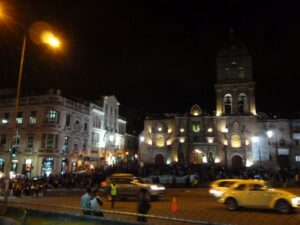 Other tips to improve your safety in Bolivia include to try to be street-wise. A common warning says: “Don’t walk the streets at night”. But this depends on the area. In La Paz you already have to be more careful at 21:00 h, while in Sucre I felt safe to walk from the bar to my hotel after midnight. Before traveling to Bolivia it is good to read up on the safety of local areas you want to visit. For this the information from other travellers and local people is often more valuable than the general information of your governments department of foreign affairs. And if you’re traveling through Bolivia, walk in an unknown part of a city and wonder if it is safe, then it is good to look around you. If you are the only one who walks the street, then there is probably a good reason for the absence of other pedestrians. It is often better to avoid these streets. On the other hand, if it is past 10 pm and you are in an unknown part of a Bolivian city, but there are still several other people walking casually around, then you are likely in a safer part of the city.
Other tips to improve your safety in Bolivia include to try to be street-wise. A common warning says: “Don’t walk the streets at night”. But this depends on the area. In La Paz you already have to be more careful at 21:00 h, while in Sucre I felt safe to walk from the bar to my hotel after midnight. Before traveling to Bolivia it is good to read up on the safety of local areas you want to visit. For this the information from other travellers and local people is often more valuable than the general information of your governments department of foreign affairs. And if you’re traveling through Bolivia, walk in an unknown part of a city and wonder if it is safe, then it is good to look around you. If you are the only one who walks the street, then there is probably a good reason for the absence of other pedestrians. It is often better to avoid these streets. On the other hand, if it is past 10 pm and you are in an unknown part of a Bolivian city, but there are still several other people walking casually around, then you are likely in a safer part of the city.
Protests in Bolivia
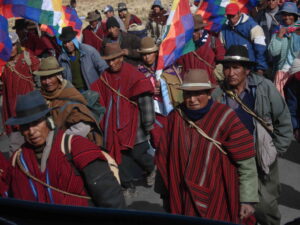
Fake police agents
To be honest, I’ve only once met two fake police agents in Potosí. They were dressed like policemen and asked me for my identification. I told them that I had left it in my hotel. They told me that I should come with them to the police office, I told them, in a mix of Spanish and English, that my hotel wasn’t far away and that we could walk together to the hotel to pick up my passport. They told me that we should go with their car, which wasn’t a police car, I told them that I preferred to walk. In the end they left. As a tour guide I warned my clients for the slim possibility of meeting fake cops. I told my clients to make sure to always carry a copy of their passport with and if they got stopped by a policeman, that they should speak a mix of Dutch and English to the guy, to confuse them. Show them the copy of your passport and invite them to come to your hotel, but never go with them. Twice I had clients who encountered fake cops and luckily nothing bad happened. How to recognise a fake cop? Easy, if you behave normal, no real police agent in Bolivia will bother foreign tourists walking in the street.
Taxi in Bolivia
Most taxis in Bolivia are safe, as for their drivers will not try to steal from you, but the many independent taxi drivers will drive their cars almost literary until they fall apart. Usually hotels and restaurants in Bolivia can help you with calling a secure taxi at a set, slightly higher, but still fair price. If you are tired of roaming through a city and just want to take a taxi, how do you know that it is a safe taxi? The trick I use is to always pick my own taxi. I usually don’t get into taxi’s who pass by and slow down, or even honk to get me in their taxi. I also don’t choose taxi’s that are waiting at popular tourist hotspots. Instead I try to pick a taxi waiting at a traffic light, or a taxi that just drops off other people. I also trust my gut. If I see a taxi driver I don’t like, then I just wait for the next. There are usually enough taxi’s driving around the streets in Bolivia. One peculiar thing to keep in mind when taking a taxi in Bolivia is that some drivers rise the price for the ride when more people enter the taxi.
The safety of buses in Bolivia
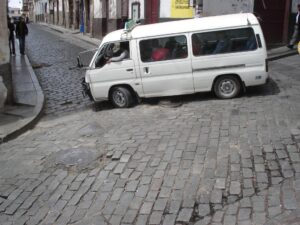
Additional note: it seems that there are still too many (bus) accidents happening on the road from La Paz to Rurrenabaque. For this we recommend to fly between La Paz and Rurrenabaque.
Coca leaves
Chewing coca leaves in Bolivia is legal and it is common practice among Bolivians who do physical labour. The biggest benefit from chewing coca leaves is that they take hunger and sleep away. This is also why you will frequently see truck and bus drivers chewing coca leaves to stay awake. No worries, chewing coca leaves is not addictive and your bus driver will not get any hallucinations or other negative side effects. On the contrary, having a driver who chews coca leaves means that there is less chance that he falls asleep behind the wheel.
Other safety in Bolivia tips
Other tips to improve your safety in Bolivia while traveling around include general recommendations like: NEVER leave your drink unattended. This also means that you don’t accept other people to buy drinks for you, unless you can see the drink being poured in your glass. Don’t show off your valuables; Always first go back to your hotel after taking money from an ATM, unless you tend to spend that money directly in a restaurant; Carry two wallets with you. One with all your important stuff and another wallet (preferable even with an expired banking card) for small spendings, like buying souvenirs, or buying things from street vendors. If, in the rare occasion, you do get robbed, it is always best to be able to give the robber at least something to prevent frustration and maybe even violence; Don’t fall for the so called ‘spill trick’ were somebody spills dirt on you and someone else comes to help you to take the dirt off. While you are distracted, a third person will thy to take your luggage. So when someone spills dirt on you, it is best to ignore this, keep walking and enter a shop or restaurant. Only then you can stop to check your clothes.
Altitude sickness in Bolivia
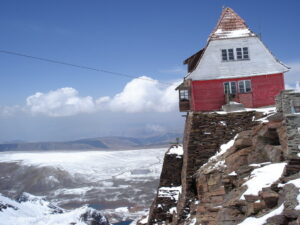
When talking about safety in Bolivia, people often forget to talk about its geography. Traveling through Bolivia usually also means that you will be traveling through higher altitudes than your body is used to. Most tourists who arrive in Bolivia will arrive at La Paz airport in El Alto, at an altitude of 4062 m (13327 feet) above sea level! At this altitude there is less oxygen in the air and you will immediately feel this. Most people will just feel quickly out of breath and tired, but some people will get a headache or even trouble with breathing. How your body will respond to higher altitude is difficult to predict, but it is always best to try to stay calm and take things easy, to give your body time to adjust. Please read also the following information about altitude sickness while traveling.
Dengue and your safety in Bolivia
Bolivia is home to mosquitos that spread Dengue. For most tourists the risk to get infected is very low, as the Dengue mosquito usually doesn’t live above 2000 m (6562 feet) above sea level. But if you travel to the lower areas of Rurrenabaque and/ or Santa Cruz I recommend to be cautious of the mosquitos.
